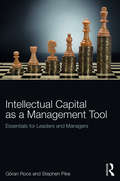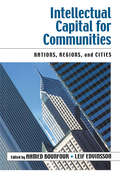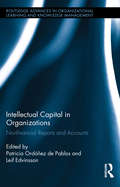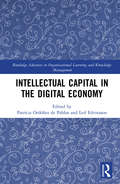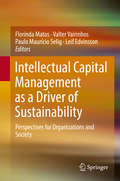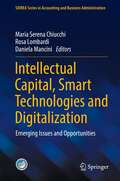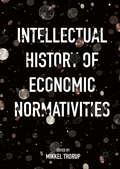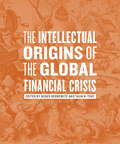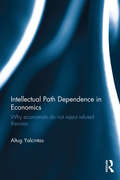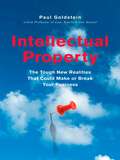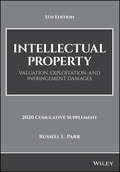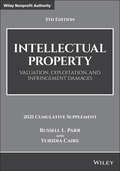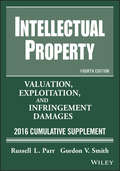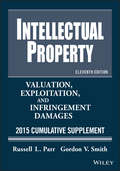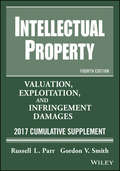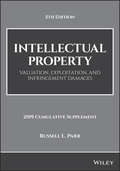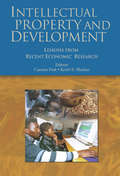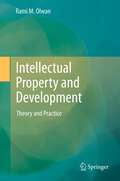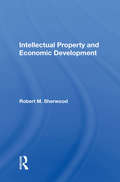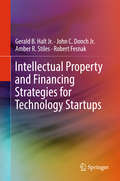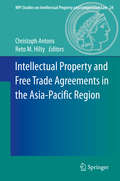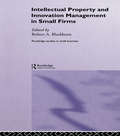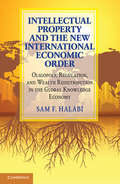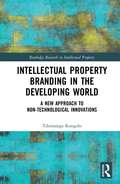- Table View
- List View
Intellectual Capital as a Management Tool: Essentials for Leaders and Managers
by Göran Roos Stephen PikeAs technology evolves, it can be difficult to maintain a competitive edge. The management of intangible resources like competence, relationships, brands, processes and systems becomes increasingly important in such a world. Intellectual Capital as a Management Tool reviews the evidence to demonstrate where the intellectual capital view of the firm has made major contributions. <P><P>The book introduces an updated version of the Intellectual Capital Navigator as an operational tool to help managers maximise value generation from an organisations portfolio of diverse resources. This tool is the only tool that enables organisations to use the resource based view of the firm in an operational way. The book also discusses future developments of the Intellectual Capital Navigator, increasing its precision around the financial aspects of the organisation. <P><P>The book has broad application across all types of organisations and in all operating environments and is vital reading for managers who want to understand and exploit the importance of managing intellectual capital.
Intellectual Capital for Communities: Nations, Regions, And Cities
by Leif Edvinsson Ahmed BounfourIn the knowledge economy, the value of corporations is directly related to their knowledge and intellectual capital. But broaden the perspective a little wider and you begin to see the possibilities: Think of cities, regions, even entire nations, in addition to the public sector. If intangibles and intellectual capital are important to the private sector, they are also important to the productivity and competitiveness of the public sector, and so to communities and nations as a whole. In this book, Editors Ahmed Bounfour and Leif Edivinsson have brought together the best minds in intellectual capital throughout the world to focus on a new and fertile area of research: measuring and managing the intellectual capital of communities. This is a creative and cutting-edge area of research that has the potential to change how public sector planning and development is done. Once there is a clear way to identify where wealth is created in a given region/nation, this process has the potential to reveal a huge knowledge repository in the public sector with a significant—but idle—potential for collective wealth creation—the wealth of nations in waiting.
Intellectual Capital in Organizations: Non-Financial Reports and Accounts (Routledge Advances in Organizational Learning and Knowledge Management #1)
by Patricia Ord Leif EdvinssonIn a global competitive economic environment, resources that are scarce or irreplicable are a source of sustained competitive advantage for companies and organizations. Knowledge-based resources are a major and increasing driver of long term competitive advantage. Most accounting standards however do not allow for knowledge-based resource calculations, including the most important of these, intellectual capital. Intellectual capital is the collective knowledge, documented and otherwise, of individuals in an organization. In the absence of accounting standards to numerically evaluate intellectual capital, some institutions have devised their own reports and statements. But why should companies, universities, and research centers measure these resources? How are intellectual capital statements built? How does one set targets, and what indicators should they include? This book reviews the development of the field of intellectual capital reporting, including core concepts, latest developments, the main components of intellectual capital, how a statement is built, and key indicators of each component. It further analyzes experiences from a variety of pioneering companies and institutions around the globe in measuring intellectual capital, including case studies from educational and research institutions, and provides crucial transnational comparisons. Authors Ordóñez de Pablos and Edvinsson examine the challenges and next steps for the harmonization of intellectual capital reports, consider the creation of a special international agency for intellectual capital reporting standards, and evaluate the weaknesses of current standards and how they might be overcome.
Intellectual Capital in the Digital Economy (Routledge Advances in Organizational Learning and Knowledge Management)
by Pablos Patricia Ordóñez de / Edvinsson LeifThis book presents a global view of digital and knowledge-based economies and analyses the role of intellectual capital, intellectual capital reports and information technology in achieving sustained competitive advantages in the globalized economy. Intellectual Capital in the Digital Economy reviews the state of the art in the field of intellectual capital and intellectual capital reports, exploring core concepts, strengths and weaknesses, gaps, latest developments, the main components of intellectual capital, the main sections of the reports, and indicators of each component. It presents experiences from pioneering companies and institutions in measuring intellectual capital around the world. It incorporates an interdisciplinary and cross-sectorial approach, offering a comparative view of intellectual capital reports elaborated in different regions of the world. This book presents case studies and experiences on the building of intellectual capital reports in organizations. In addition, the book discusses the benefits and challenges of building intellectual capital reports in smart economies and societies. This book is of direct interest to researchers, students and policymakers examining intellectual capital and the knowledge-based economy.
Intellectual Capital Management as a Driver of Sustainability: Perspectives for Organizations and Society
by Leif Edvinsson Florinda Matos Valter Vairinhos Paulo Maurício SeligThe objective of this book is to explore the relationship between intellectual capital management and the sustainable development of organizations and society. To do so, it introduces readers to the topic of intellectual capital in the context of several connected entities such as organizations, cities and regions, sharing insights that both reflect the status quo and demonstrate the need for further action. In closing, the book presents practical cases to verify the impact of intellectual capital management on sustainable and competitive development.
Intellectual Capital, Smart Technologies and Digitalization: Emerging Issues and Opportunities (SIDREA Series in Accounting and Business Administration)
by Daniela Mancini Rosa Lombardi Maria Serena ChiucchiThis book treats intellectual capital, smart technologies, and digitalization processes as levers of corporate competitiveness and global value creation. This book is based on theoretical and practical research output from the STEDIC SIDREA Group. It uses several methodologies to discover features and pillars on intellectual capital such as human capital, relational capital, and structural capital as well as smart technologies such as artificial intelligence, Internet of Things, big data, and digitalization.
Intellectual History of Economic Normativities
by Mikkel ThorupThe book investigates the many ways thateconomic and moral reasoning interact, overlap and conflict both historicallyand at present. The book explores economic and moral thinking as a historicallycontingent pair using the concept of economic normativities. The contributorsuse case studies including economic practices, such as trade and finance andtax and famine reforms in the British colonies to explore the intellectualhistory of how economic and moral issues interrelate.
The Intellectual Origins of the Global Financial Crisis
by Taun N. Toay Roger BerkowitzCommentary on the financial crisis has offered technical analysis, political finger pointing, and myriad economic and political solutions. But rarely do these investigations reach beyond the economic and political causes of the crisis to explore their underlying intellectual grounds. The essays in this volume delve deeper into the cultural and intellectual foundations, philosophical ideas, political traditions, and economic movements that underlie the greatest financial crisis in nearly a century. Moving beyond traditional economic and political science approaches, these essays engage thinkers from Hannah Arendt to Max Weber and Adam Smith to Michel Foucault. With Arendt as a catalyst, the authors probe the philosophical as well as the cultural origins of the great recession. Orienting the volume is Arendt’s argument that past financial crises and also totalitarianism are rooted, at least in part, in the tendency for capital to expand its reach globally without regard to political and moral borders or limits. That politics is made subservient to economics names a cultural transformation that, in the spirit of Arendt, guides these essays in making sense of our present world. Including articles, interviews, and commentary from leading scholars and business executives, this volume offers views that are as diverse as they are timely. By reaching beyond “how” the crisis happened to “why” the crisis happened, the authors re-imagine the recent financial crisis and thus provide fresh thinking about how to respond.
Intellectual Path Dependence in Economics: Why economists do not reject refuted theories
by Altug YalcintasIs economics always self-corrective? Do erroneous theorems permanently disappear from the market of economic ideas? Intellectual Path Dependence in Economics argues that errors in economics are not always corrected. Although economists are often critical and open-minded, unfit explanations are nonetheless able to reproduce themselves. The problem is that theorems sometimes survive the intellectual challenges in the market of economic ideas even when they are falsified or invalidated by criticism and an abundance of counter-evidence. A key question which often gets little or no attention is: why do economists not reject theories when they have been refuted by evidence and falsified by philosophical reasoning? This book explores the answer to this question by examining the phenomenon of intellectual path dependence in the history of economic thought. It argues that the key reason why economists do not reject refuted theories is the epistemic costs of starting to use new theories. Epistemic costs are primarily the costs of scarcity of the most valued element in academic production: time. Epistemic scarcity overwhelmingly dominates the evolution of scientific research in such a way that when researchers start off a new research project, they allocate time between replicable and un-replicable research. This book is essential reading for anyone interested in the methodology, philosophy and history of economics.
Intellectual Property
by Paul GoldsteinThis book is the first detailed historical account of intellectual property law. In part, it examines why intellectual property law with its subcategories of patents, copyright, designs and trade marks took the shape that it did over the course of the nineteenth century. In addition the authors deal with ways in which the law grants property status to intangibles and describe how the law came to create techniques that enabled it to recognize protectable intangibles, and the inescapable problems that have arisen from their use.
Intellectual Property: Valuation, Exploitation, and Infringement Damages, 2020 Cumulative Supplement (Wiley Nonprofit Authority)
by Russell L. ParrA new edition of the trusted book on intellectual property Intellectual Property simplifies the process of attaching a dollar amount to intellectual property and intangible assets, be it for licensing, mergers and acquisitions, loan collateral, investment purposes, and determining infringement damages. This book comprehensively addresses IP Valuation, the Exploitation Strategies of Licensing and Joint Ventures, and determination of Infringement Damages. The author explains commonly used strategies for determining the value of intellectual property, as well as methods used to set royalty rates based on investment rates of returns. Key concepts are brought to life through real-world examples of exploitation strategies being used by major corporations.
Intellectual Property: Valuation, Exploitation, and Infringement Damages, 2021 Cumulative Supplement (Wiley Nonprofit Authority)
by Russell L. Parr Yuridia CaireStay completely up to date in a critical and rapidly evolving area of law The 2021 Cumulative Supplement to the fifth edition of Intellectual Property: Valuation, Exploitation, and Infringement Damages delivers the latest legal and regulatory changes affecting industry participants. The Supplement offers readers the opportunity to remain fully up to date in a fast-moving and quickly changing area of law applicable to anyone who operates in the commercial sector. Perfect for legal professionals, consultants, entrepreneurs, company founders, and other business leaders, the 2021 Cumulative Supplement to Intellectual Property: Valuation, Exploitation, and Infringement Damages, Fifth Edition is an indispensable resource for any professional impacted by the law of intellectual property.
Intellectual Property
by Russell L. Parr Gordon V. SmithUp-to-date, expert guidance and a valuable tool kit for IP valuation Intellectual Property, Valuation, Exploitation, and Infringement Damages provides practical tools and expert clarification for the valuation of intangible assets. This new 2016 Cumulative Supplement contains the latest laws, regulations, and practices surrounding licensing and joint ventures, with practical analytical models that simplify the calculation of royalties and equity splits. As a companion to the comprehensive Intellectual Property, this book provides invaluable guidance toward the investment aspects, business strategies, taxes, and accounting practices involved in intellectual property protection and profit, to help licensing professionals structure optimal arrangements and mitigate risks. Written by leading experts in the intellectual property realm, this guide is a must-have resource for anyone working with intangible assets. Intellectual property is more than a simple profit center; to many owners, it's the cornerstone of their organization, and must be rigorously protected and exploited to the fullest extent. This book provides clear guidance on valuation, which is the foundation of a successful IP strategy. Define the value of intangible assets in real-money terms Examine the business economics of licensing and joint venture strategies Understand the relevant legal, tax, and accounting practices Determine fair royalty rates and equity splits Patents, trademarks, formulas, copyrights, brand names, distribution systems--all fall under the intellectual property umbrella, and each might be the competitive edge upon which a business is built. Intellectual property can cost hundreds of millions of dollars to create, and is often irreplaceable with no substitute or alternative available, making it an organization's most important asset. Protect it properly, and reap every ounce of profit it can produce with the important guidance in Intellectual Property, Valuation, Exploitation, and Infringement Damages, 2016 Cumulative Supplement.
Intellectual Property: Valuation, Exploitation, and Infringement Damages 2015 Cumulative Supplement (Intellectual Property-general, Law, Accounting And Finance, Management, Licensing, Special Topics Ser.)
by Russell L. Parr Gordon V. SmithAn updated, comprehensive guide to monetizing intellectual property assets Intellectual Property, Valuation, Exploration, and Infringement Damages removes complexity and provides solutions to the challenge of placing a dollar amount on intellectual property. This revised and updated cumulative supplement for 2015 provides insight that reflects the latest regulations and best practices, and the most up to date practical tools for evaluating the investment aspects of licensing and joint venture decisions. The discussion includes procedures for accounting, tax, and legalities, and examines the business economics of strategies involving intellectual property, and analytical models are provided to help you determine reasonable royalty rates for licensing and fair equity splits in joint venture arrangements. With detailed explanations and expert insight into the realities surrounding these assets, you'll have everything you need to exploit your product to the fullest extent. Companies are increasingly looking to their intellectual property as a profit center. Patents, trademarks, formulas, copyrights, and brand names can easily become the cornerstone of a corporation, and its most important asset, all while remaining difficult to quantifiably value. This supplement simplifies the challenge by providing the tools, precedent, and expert advice you need to approach these assets with clarity and understanding. Overcome valuation challenges and avoid common errors Understand the associated legal, tax, and accounting practices Study analytical models for fair licensing and equity splits Review precedent for determining infringement damages Intellectual property can cost hundreds of millions of dollars to create, and is often irreplaceable with no substitute or alternative available. These assets need protection, and companies need recourse in case of infringement. Intellectual Property, Valuation, Exploration, and Infringement Damages clarifies the legal, financial, and investment issues to give you a deeper understanding of how best to handle these valuable assets.
Intellectual Property: Valuation, Exploitation, and Infringement Damages, 2017 Cumulative Supplement
by Gordon V. Smith Russell L. ParrA comprehensive reference for valuation of intangible assets Intellectual Property, Valuation, Exploitation, and Infringement Damages provides in-depth, up-to-date guidance about the valuation of intangible assets. Covering patents, trademarks, copyrights, trade secrets, and more, this book describes the standards, best practices, and case law relating to valuation, licensing, and infringement damages. Intellectual property strategies are examined from a business economic standpoint, and analytical models are provided to streamline the calculation of valuations, licensing royalty rates, and fair equity splits in joint venture arrangements. Designed to ease the task of attaching monetary value to intangible assets, this invaluable reference includes extensive practical guidance including sample royalty rate information, diffusion sales forecasting models, detailed treatment of investment rate of return, and the valuation of early-stage technology. Intellectual property is rapidly becoming a major profit center for an increasing number of companies, who may invest billions of dollars in development of an irreplaceable asset. This book provides an authoritative reference for exploiting this property to its fullest extent, and quantifying its actual economic value. Now that intangible assets are becoming the cornerstones of corporations, applying a logical, analytical approach to valuation has become more important than ever. Intellectual Property, Valuation, Exploitation, and Infringement Damages provides expert guidance for each stage of the asset's life cycle, with recommended procedures and strategies grounded in case law and real-world practice.
Intellectual Property, 2019 Cumulative Supplement: Valuation, Exploitation, and Infringement Damages, 2019 Cumulative Supplement (Intellectual Property-general, Law, Accounting And Finance, Management, Licensing, Special Topics Ser.)
by Russell L. ParrUpdate yourself on the latest developments in intellectual property regulation and practices As the 2019 supplement to the Fifth Edition of Intellectual Property, Valuation, Exploitation, and Infringement Damages, this handbook covers changes made to laws and industry practices within the last year since the current edition's release. Like its parent volume, it is designed to simplify the process of attaching a dollar amount to intangible assets, be it for licensing, mergers and acquisitions, loan collateral, or investment purposes. The author explains commonly used strategies for determining the value of intellectual property, as well as methods used to set royalty rates based on investment rates of returns. The text also examines the business economics of strategies involving intellectual property licensing and joint ventures, providing practical tools for evaluating the investment aspects of such arrangements and discussing the legal, tax, and accounting practices and procedures related to them. In addition, analytical models are provided that can be used to determine reasonable royalty rates for licensing and for determining fair equity splits in joint venture arrangements. The author gives these models practical applications, critiquing commonly used royalty rate derivation techniques and presenting real world examples of exploitation strategies being used by major corporations. Understand the theory behind intellectual property law and industry practices Learn from practical real-world case studies Ensure compliance with any relevant regulations Get ahead of the competition by subscribing and being among the first to receive the supplement Written by the President of Intellectual Property Research Associates, this supplement is an excellent expansion of the foundation laid in Intellectual Property, Valuation, Exploitation, and Infringement Damages. It will prove a valuable investment for any professional whose field deals with intellectual property, its law, and its administration.
Intellectual Property and Development
by Carsten Fink Keith E. MaskusInternational policies toward protecting intellectual property rights have seen profound changes over the past two decades. Rules on how to protect patents, copyright, trademarks and other forms of intellectual property have become a standard component of international trade agreements. Most significantly, during the Uruguay Round of multilateral trade negotiations (1986-94), members of what is today the World Trade Organization (WTO) concluded the Agreement on Trade Related Intellectual Property Rights (TRIPS), which sets out minimum standards of protection that most of the world's economies have to respect. How will developing countries fare in this new international environment? Intellectual Property and Development brings together empirical research that assesses the effects of changing intellectual property regimes on various measures of economic and social performance - ranging from international trade, foreign investment and competition, to innovation and access to new technologies. The studies presented point to an important development dimension to the protection of intellectual property. But a one-size fits all approach to intellectual property is unlikely to work. There is need to adjust intellectual property norms to domestic needs, taking into account developing countries' capacity to innovate, technological needs, and institutional capabilities. In addition, governments need to consider a range of complementary policies to maximize the benefits and reduce the costs of reformed intellectual property regulations. This book will be of interest to students and scholars of international law, particularly in the area of intellectual property rights, international trade, and public policy.
Intellectual Property and Development
by Rami M. OlwanThe book examines the correlation between Intellectual Property Law - notably copyright - on the one hand and social and economic development on the other. The main focus of the initial overview is on historical, legal, economic and cultural aspects. Building on that, the work subsequently investigates how intellectual property systems have to be designed in order to foster social and economic growth in developing countries and puts forward theoretical and practical solutions that should be considered and implemented by policy makers, legal experts and the Word Intellectual Property Organization (WIPO).
Intellectual Property And Economic Development
by Robert M SherwoodSpeaking very roughly, countries with advanced economies tend to be those displaying intellectual property protection systems in which the public has a basic degree of confidence. Those systems, when they are thought about at all rather than taken for granted, are thought of as reasonably effective in safeguarding innovation and creative expression
Intellectual Property and Financing Strategies for Technology Startups
by Gerald B. Halt Jr. John C. Donch Amber R. Stiles Robert FesnakThis book offers a comprehensive, easy to understand guide for startup entities and developing companies, providing insight on the various sources of funding that are available, how these funding sources are useful at each stage of a company's development, and offers a comprehensive intellectual property strategy that parallels each stage of development. The IP strategies offered in this book take into consideration the goals that most startups and companies have at each stage of development, as well as the limitations that exist at each stage (i. e. , limited available resources earmarked for intellectual property asset development), and provides solutions that startups and companies can implement to maximize their return on intellectual property investments. This book also includes a number of descriptive examples, case studies and scenarios to illustrate the topics discussed, and is intended for use by startups and companies across all industries. Readers will garner an appreciation for the value that intellectual property rights provide to a startup entity or company and will gain an understanding of the types of intellectual property rights that are available to companies and how to procure, utilize and monetize those intellectual property rights to help their company grow.
Intellectual Property and Free Trade Agreements in the Asia-Pacific Region
by Christoph Antons Reto M. HiltyThis book is highly topical. The shift from the multilateral WTO negotiations to bilateral and regional Free Trade Agreements has been going on for some time, but it is bound to accelerate after the WTO Doha round of negotiations is now widely regarded as a failure. However, there is a particular regional angle to this topic as well. After concluding that further progress in the Doha round was unlikely, Pacific Rim nations recently have progressed with the negotiations of a greatly expanded Trans-Pacific Partnership Agreement that includes industrialised economies and developed countries such as the United States, Japan, Australia and New Zealand, recently emerged economies such as Singapore, but also several developing countries in Asia and Latin America such as Malaysia and Vietnam. US and EU led efforts to conclude FTAs with Asia-Pacific nations are also bound to accelerate again, after a temporary slowdown in the negotiations following the change of government in the United States and the expiry of the US President's fast-track negotiation authority. The book will provide an assessment of these dynamics in the world's fastest growing region. It will look at the IP chapters from a legal perspective, but also put the developments into a socio-economic and political context. Many agreements in fact are concluded because of this context rather than for purely economic reasons or to achieve progress in fields like IP law. The structure of the book follows an outline that groups countries into interest alliances according to their respective IP priorities. This ranges from the driving forces of the EU, US and Japan, via Asia-Pacific resource-rich but IP poor economies such as Australia and New Zealand, recently emerged economies with strong IP systems such as Singapore and Korea to leading developing countries such as China and India and 'second tier industrializing economies' such as Thailand, Malaysia and Indonesia.
Intellectual Property and Innovation Management in Small Firms (Routledge Studies in Entrepreneurship and Small Business)
by Robert BlackburnIntellectual property protection is increasingly becoming a central issue for businesses. This book provides a wealth of original research on intellectual property management in small and medium sized enterprises, while also addressing the context of innovation and knowledge management.
Intellectual Property and Strategy
by Debbie Freier David B. YoffieExplores the role of intellectual property in firms' strategies. Explains the legal and strategic differences between patents, copyrights, trademarks, and trade secrets and explores the multiple ways firms use these different legal protections to gain competitive advantage in the marketplace.
Intellectual Property and the New International Economic Order: Oligopoly, Regulation, And Wealth Redistribution In The Global Knowledge Economy
by Sam F. HalabiIn economic sectors crucial to human welfare—agriculture, education, and medicine—a small number of firms control global markets, primarily by enforcing intellectual property (IP) rights incorporated into trade agreements made in the 1980s onward: such rights include patents on seeds and medicines, copyrights for educational texts, and trademarks in consumer products. According to conventional wisdom, these agreements likewise ended hopes for a “New International Economic Order,” under which wealth would be redistributed from rich countries to poor. <P><P>In this book, Sam Halabi turns this conventional wisdom on its head by demonstrating that the New International Economic Order never faded, but rather was redirected by other treaties, formed outside the nominally economic sphere, that protected poor countries' interests in education, health, and nutrition, and resulted in redistribution and regulation. <P>This illuminating book should be read by anyone seeking a nuanced view of how IP is shaping the global knowledge economy.<P>Identifies a coherent and unified way of looking at seemingly disparate phenomena in international economic law.<P> Explores a largely neglected dimension of the global wealth inequality debate.<P> Addresses complex issues in international economics and international relations without resorting to technical language or jargon.
Intellectual Property Branding in the Developing World: A New Approach to Non-Technological Innovations (Routledge Research in Intellectual Property)
by Tshimanga KongoloIntellectual Property Branding in the Developing World identifies success stories in the areas of intellectual property (IP) and branding for non-technological innovation in the developing world. The author examines the relationship between IP, branding and innovation to demonstrate that innovation, in general, and non-technological innovation, in particular, must go hand in hand with branding. Branding of non-technological innovations should be a good strategic tool to be used by countries in the developing world mainly in the areas where they have competitive advantages. This book will assist scholars and academics dealing with innovation, branding, and IP issues, providing context and guidance to policymakers from the developing world. It is also relevant to researchers and students in the fields of intellectual property law, commercial law, international law, management, and innovation.
